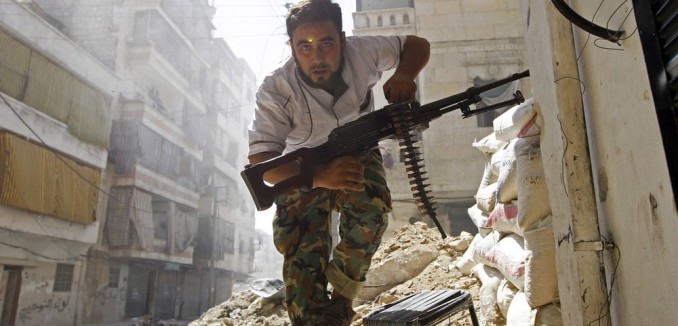Armed, trained and funded by Iran, the Shi’ite terrorist organization Hezbollah has modified some of the tactics that characterized its fight against Israel in its recent clashes with Syrian opposition groups, The Tower has learned from review of Arab media reports.
Changes include a repositioning and fortification of bases, increased use of unmanned aircraft and preemptive bombing of suspected opposition positions, and reduced use of foot patrols.
In its fight against Israeli forces, Hezbollah largely resorted to employing ground offensive tactics in order to buffer their more effective missile launches from hidden underground facilities. In addition, the organization deployed small groups of fighters equipped with anti-tank missiles in areas frequented by Israeli military vehicles, while tunnels scattered around southern Lebanon allowed Hezbollah terrorists to hide when their location was revealed by IDF surveillance aircraft.
These tactics, which according to Lebanese officials achieved a measure of success in the Second Lebanon War in 2006, are useless in Hezbollah’s clashes against Syrian opposition groups; long-range missiles and anti-tank rockets have little or no effect on degrading rebel positions. The Lebanese website “El-Nashra” recently revealed (Arabic link) the tactics utilized by Hezbollah as it adapts to its newest battleground:
- Hezbollah is no longer using military outposts where there are a small number of fighters. This tactic was adopted by the organization in the fight against the IDF, and used to minimize casualties from possible Israeli aerial bombardment. However, the danger posed by Syrian opposition organizations to Hezbollah is not from the air, but from the ground against military posts. Therefore, the organization sent reinforcements to all outposts along the border between Syria and Lebanon, and especially to the al-Qalmoun area in Syria. The goal of this move is to enable a long battle with Syrian rebels and exhaust them.
- Hezbollah has made many changes in its intelligence bases. It emptied the bases which were exposed to opposition rocket fire and replaced them with bases with new and more effective defense fortifications. Additionally, the Shiite organization places great emphasis on the establishment of bases that can cover each other during the attacks and therefore placed them in new strategic locations in what it calls “the fire line”. In this way, the organization believes that enemies cannot isolate one base without encountering heavy fire from nearby Hezbollah bases.
- In addition to changing the locations of and fortifying its bases, Hezbollah intensified its use of preventive attacks. Hezbollah bombards almost all suspicious military activity on a daily basis. Syrian opposition activists now find it difficult to perform complex operations that require ongoing planning in the field.
- Hezbollah has reduced the number of foot patrols it positioned in sensitive areas along the Lebanon-Syria border, after suffering numerous casualties from ambushes. Instead, Hezbollah now often uses unmanned aircraft for reconnaissance to uncover suspicious activity.
Following these tactical changes, Syrian opposition forces have had to recalibrate their own strategies in order to attack Hezbollah targets successfully; Hezbollah’s defense capabilities have reportedly improved (Arabic link) in recent months, allowing the Iranian proxy to better withstand and repel attacks. Moreover, Hezbollah is increasingly cautious in employing risky communication (Arabic link) devices such as cell phones.
Stéphane Cohen, senior defense analyst at The Israel Project, told The Tower there is no doubt that Hezbollah is currently in a period of transition:
“These changes are of a tactical nature. It is more difficult for Hezbollah to decide and shape its new policies vis-à-vis Israel and the region in light of the possible strategic changes in the Middle East, mainly the growing threats from Sunni jihadists and the possible downfall of the Assad regime. Even if the rhetoric is still anti-Israel and anti-western, Hezbollah’s main threat is shifting from the south to the east. If Hezbollah will lose the Assad regime, it will be more difficult to maintain and continue its military buildup; therefore Iran will likely seek new ways to strengthen Hezbollah.”
The Israel Project publishes The Tower.
Hezbollah’s modified tactics are perhaps motivated by the heavy losses the group incurred in recent months, which have forced it to secure the Syria-Lebanon border. These losses have also reportedly caused dissension in the ranks of the terror organization, alienated it from its Shiite base in Lebanon and caused a rift with Syrian regime it has been supporting.
[Photo: abdullatif anis / Flickr]




